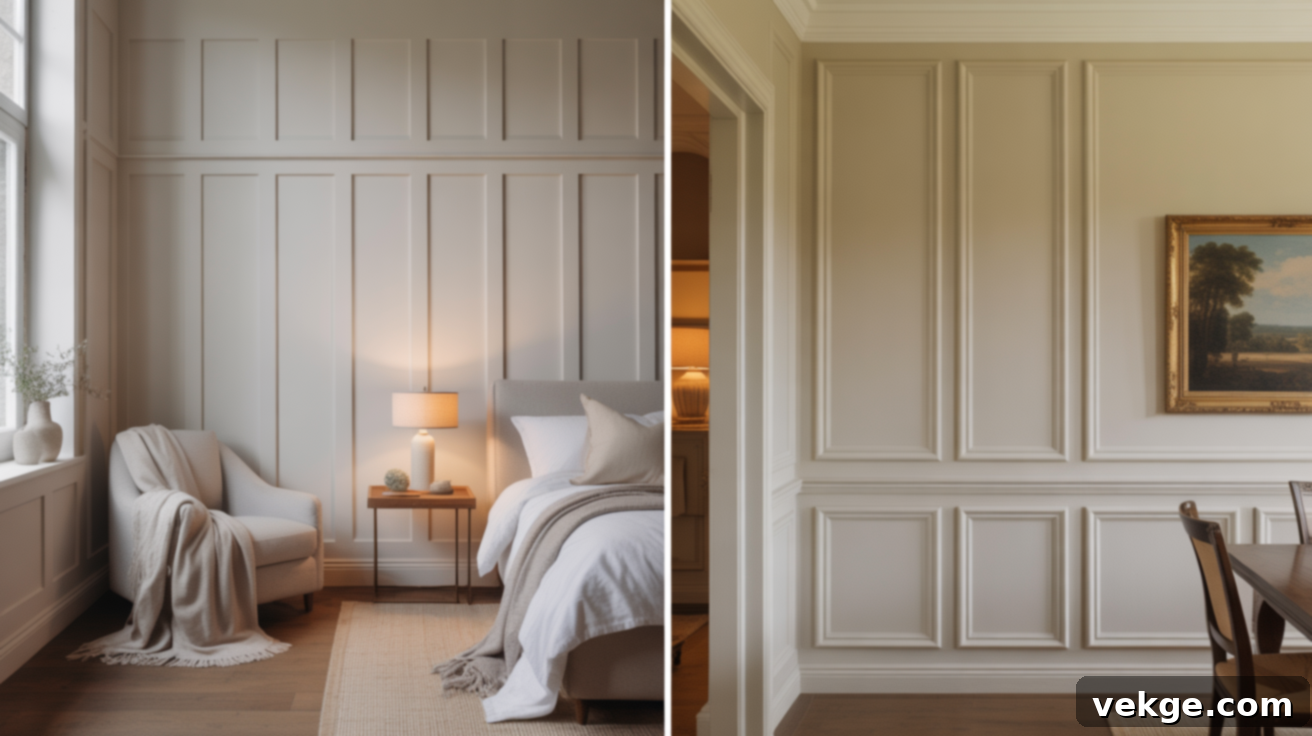Board and Batten vs. Wainscoting: The Ultimate Guide to Elevate Your Walls
Have you ever glanced at your walls and felt a distinct lack of character, a blank canvas crying out for more? It’s a common sentiment. Undecorated walls can leave a room feeling cold, unfinished, or simply uninspired. If you’re seeking to infuse your living space with personality and architectural interest without undertaking a major renovation, you’ve landed in the perfect spot.
This comprehensive guide delves into two of the most popular and impactful wall treatments: board and batten and wainscoting. We’ll explore their fundamental differences, dive into their respective costs and installation complexities, uncover where each style shines brightest, and ultimately help you determine which option is the ideal fit for your home and aesthetic preferences. Beyond the basics, you’ll gain practical tips on installation, understand their pros and cons, and learn how to select the perfect style to truly transform your interior. Ready to give your walls the upgrade they deserve? Let’s uncover the perfect solution together.
Board and Batten vs. Wainscoting: Understanding the Core Differences
Both board and batten and wainscoting are cherished design techniques for adding texture, depth, and a bespoke finish to plain walls. While they share the goal of enhancing a room’s aesthetic, their construction and visual impact are distinctly different.
Board and batten is characterized by a striking pattern created by tall wooden boards, typically placed vertically, with narrow strips of wood (the “battens”) covering the seams or gaps between them. This creates a clean, linear design that can extend from the floor all the way to the ceiling, offering a dramatic and cohesive look. It’s an excellent choice if you’re aiming for a bold, modern farmhouse, or even a contemporary aesthetic that also feels structured and organized. The vertical lines inherently draw the eye upwards, creating the illusion of taller ceilings and a grander space.
In contrast, wainscoting traditionally covers only the lower portion of a wall. Its height can vary significantly, commonly extending one-third, halfway, or even three-quarters up the wall. A key defining feature of wainscoting is the decorative trim or molding that caps the top edge, adding a refined, classic, or ornate touch. This style is often favored when you desire to impart a sense of coziness, tradition, or a touch of formality to a room. It effectively grounds the space, adding visual weight to the lower half of the walls and protecting them from daily wear and tear.
Transforming Your Space: How These Wall Styles Influence a Room’s Ambiance
Wall treatments like board and batten or wainscoting are more than just decorative additions; they actively shape the overall feeling and architectural character of a room. Understanding their distinct impacts is crucial for making the right choice.
Board and Batten: Modern Farmhouse to Contemporary Chic
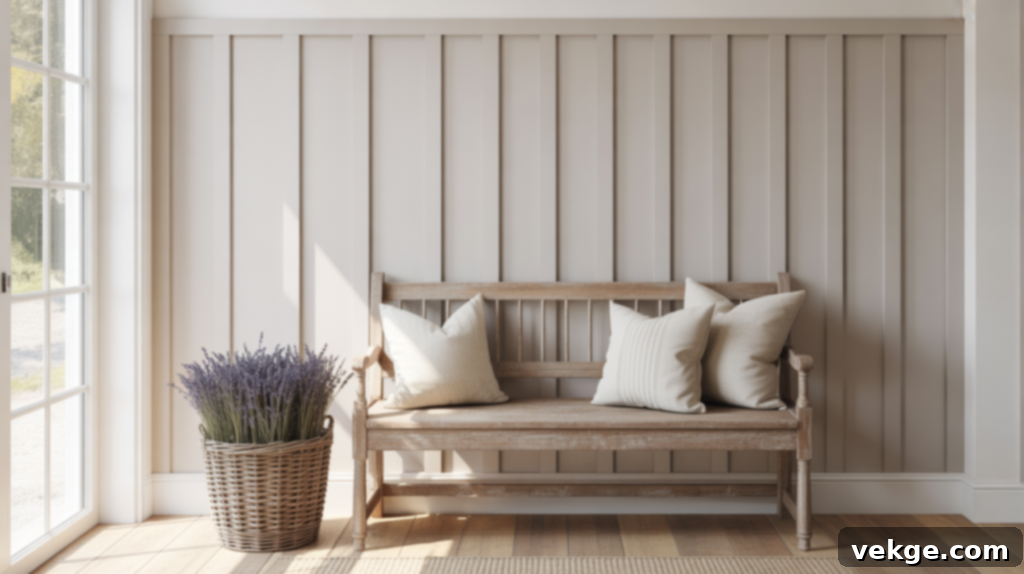
Board and batten introduces a striking pattern of evenly spaced vertical boards, which instantly lends a room a sense of order, rhythm, and architectural depth. In traditional and rustic homes, this look effortlessly enhances style and character. It integrates seamlessly into farmhouse, colonial, or cottage-style spaces, especially when complemented by warm, inviting tones and natural, rustic details. The robust lines resonate with the simplicity and craftsmanship often found in these aesthetics.
For more modern interiors, board and batten is frequently streamlined. Simplified, clean lines and minimal trim allow the design to feel sleek, understated, and sophisticated. When painted in bold, saturated colors or serene neutral shades, it creates an impactful feature wall without overwhelming the space. This versatile treatment works exceptionally well in entryways, bedrooms, living rooms, or even stairwells, offering a smart and effective way to add appealing texture and visual interest without introducing clutter. Its ability to stretch from floor to ceiling is particularly effective in visually expanding smaller rooms, making them feel taller and more open.
Wainscoting: Classic Elegance and Functional Charm
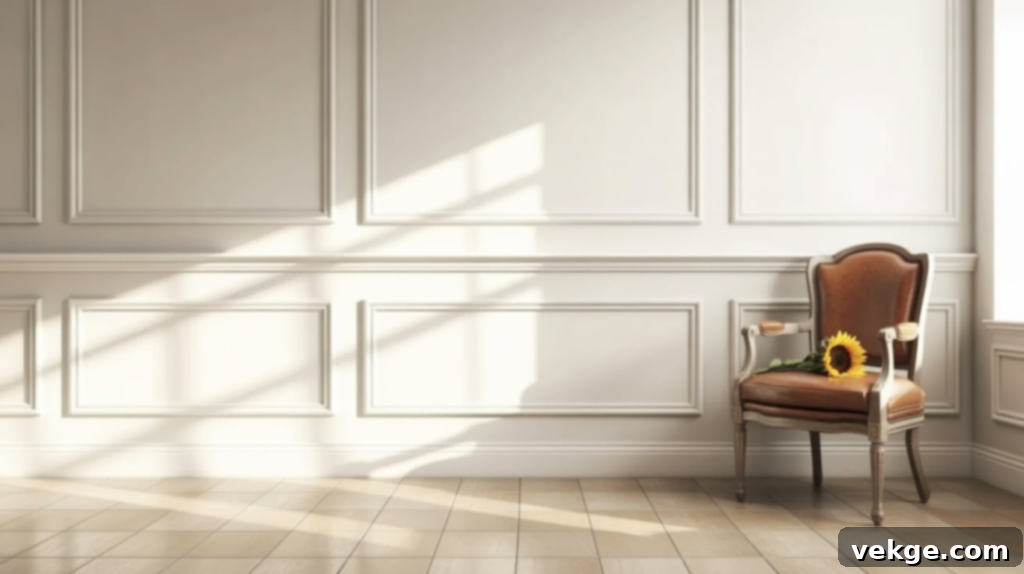
Wainscoting, by covering only the lower section of a wall and often capped with a horizontal molding or chair rail, serves to visually anchor a room. This lower-wall treatment adds significant weight and presence to the bottom half of the space, which can be particularly beneficial in rooms with high ceilings or expansive walls, making them feel more balanced, intimate, and inviting. Beyond aesthetics, wainscoting also offers a practical benefit: it protects walls from scuffs, impacts, and daily wear in high-traffic areas, making it a durable and smart choice.
Historically, wainscoting was a staple in formal areas such as dining rooms, libraries, and sitting areas, where it conveyed sophistication and established a sense of tradition. Today, its versatility sees it gracing hallways, bathrooms, mudrooms, and even casual living spaces. You can opt for classic white wainscoting for a timeless, vintage-inspired look, or experiment with bolder colors for a more contemporary and impactful statement. Regardless of the color choice, wainscoting consistently adds a layer of polish, definition, and refined charm to any interior space.
Board and Batten vs. Wainscoting: A Comparison of Pros and Cons
Like all home design elements, wall treatments come with their unique set of advantages and potential drawbacks. A thorough understanding of these ups and downs is essential to selecting the option that best aligns with your home’s needs, your personal style, and your budget.
| Feature | Board and Batten | Wainscoting |
|---|---|---|
| Pros | Adds significant visual depth and texture, transforming flat walls. | Offers a timeless, classic architectural look that elevates any room. |
| Often considered more straightforward for experienced DIYers due to simpler cuts. | Provides robust protection for walls against scuffs, dents, and daily wear. | |
| Vertical lines create the illusion of taller ceilings, enhancing room height. | Effectively hides minor imperfections and unevenness in older or less-than-perfect walls. | |
| Highly adaptable; complements many design styles from modern to farmhouse. | Adds sophisticated visual interest and a sense of history to a space. | |
| Durable and resilient, especially suitable for high-traffic areas like entryways. | Perfect for traditional, transitional, and even some contemporary formal spaces. | |
| Cons | May visually overwhelm or shrink very small rooms if not executed thoughtfully. | Installation can be more complex, often requiring precise panel fitting and intricate trim work. |
| Requires meticulous measurements and planning to ensure even spacing and alignment. | Can appear dated in certain contexts without modern updates to color or surrounding decor. | |
| Can feel too prominent or visually heavy in minimalist or overly delicate design schemes. | Potentially higher material and labor costs due to more elaborate trim and panel work. | |
| Material costs can be higher depending on the type of wood or MDF chosen and wall height. | May have less dramatic impact in rooms with already unique or complex architectural features. | |
| Requires careful painting and sealing to prevent dust accumulation in recesses and edges. | Achieving the best results often demands skilled carpentry for seamless joins and profiles. |
Ultimately, both board and batten and wainscoting have the power to infuse immense personality and charm into your living spaces. There isn’t a universally “wrong” choice; the decision largely hinges on your personal aesthetic preferences, the specific dimensions and existing architecture of the room, and the amount of effort and budget you’re prepared to invest in the project.
Cost and Installation: A Practical Overview
Before embarking on any wall treatment project, it’s prudent to have a clear understanding of the potential costs, the necessary materials, and whether to tackle it as a DIY endeavor or enlist professional help.
Essential Materials and Cost Factors
Both board and batten and wainscoting utilize a similar foundational set of materials, though the quantities and specific types may vary. You will typically need:
- Plywood or MDF (Medium-Density Fiberboard) panels: These form the base for either the full board or the flat panels of wainscoting. MDF is generally more affordable and stable, while plywood offers greater durability and can hold screws better.
- Wood trim pieces: For battens in board and batten, or for the rails and stiles that create the wainscoting’s framed look, along with decorative caps.
- Fasteners and adhesives: Nails (preferably finishing nails for a clean look), wood glue for secure adhesion, and wood filler to conceal nail holes and minor imperfections.
- Finishing supplies: Sandpaper for smooth surfaces, paint or stain to achieve your desired color and finish, and primer.
- Tools: Measuring tape, a level (crucial for straight lines), a miter saw or circular saw for precise cuts, a nail gun (manual or pneumatic), and caulk.
The total cost will largely depend on the type of wood chosen (solid wood is pricier but more durable than MDF), the complexity of the design, the height of the treatment, and the quality of paint or stain. Solid wood, while a higher upfront investment, often provides superior longevity and a more premium finish. Labor costs, if hiring a professional, will also significantly impact the final budget, often accounting for 50% or more of the total project expense.
DIY vs. Hiring a Professional: Making the Right Choice
For individuals with prior experience in home improvement projects, particularly those involving carpentry or trim work, board and batten is often a manageable DIY project. It requires careful measuring, precise cutting, and a steady hand, but the individual components are relatively straightforward. The simpler, repetitive nature of its vertical elements makes it more accessible for a confident homeowner.
Wainscoting, especially styles like raised panel or elaborate recessed panel designs, demands a higher level of precision and carpentry skill. Creating perfect angles for mitered joints, ensuring flush seams, and achieving a seamless transition between panels and trim can be quite challenging without professional experience. If you’re not confident in your ability to make intricate cuts, achieve perfectly level lines, or conceal joints flawlessly, hiring a skilled carpenter or contractor is highly recommended. A professional can prevent costly mistakes, minimize material waste, and guarantee a polished, high-quality finish that significantly enhances your home’s value and aesthetic. While DIY saves on labor costs, the ultimate look and durability hinge directly on your skill level and the time you can dedicate to the project.
Board and Batten vs. Wainscoting: Which Style Suits Your Home Best?
Each wall treatment carries its own unique visual identity and functional benefits. Deciding between board and batten and wainscoting largely depends on the specific room you’re decorating and the overarching style of your home.
Choosing Based on Room Type
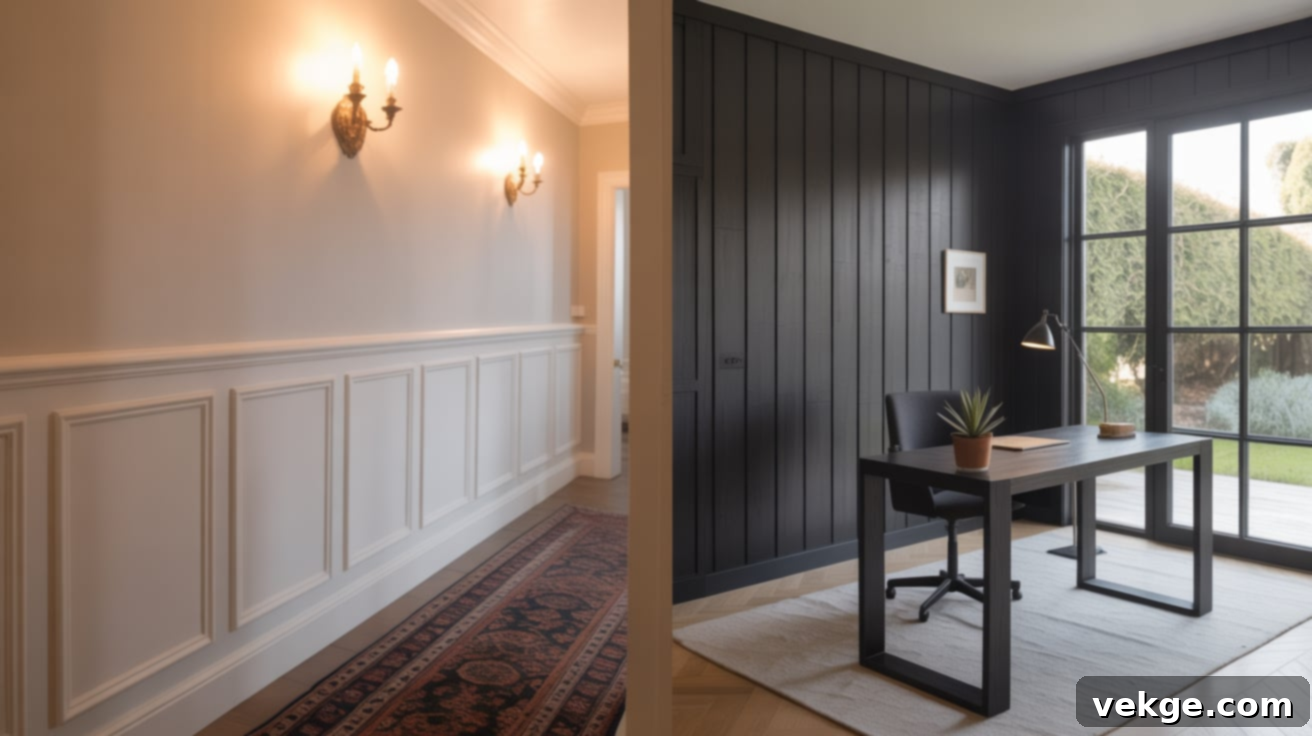
Certain rooms naturally lend themselves better to particular wall styles. Wainscoting is an exceptional choice for formal areas such as dining rooms, powder rooms, and long hallways. Its ability to add a clean, finished, and sophisticated look without covering the entire wall makes it ideal for spaces where you want elegance and protection from scuffs. It’s also fantastic in bathrooms, offering a durable and moisture-resistant lower wall surface when properly sealed.
Board and batten, with its more dramatic and expansive coverage, works beautifully in spaces where you wish to make a bold design statement. Consider it for offices, spacious bedrooms, a welcoming entryway, or even a child’s room to add whimsical charm. Its full-wall coverage can transform a mundane wall into a compelling focal point. When making your choice, consider the room’s primary purpose and the amount of visual coverage and impact you desire.
Choosing Based on Home Style
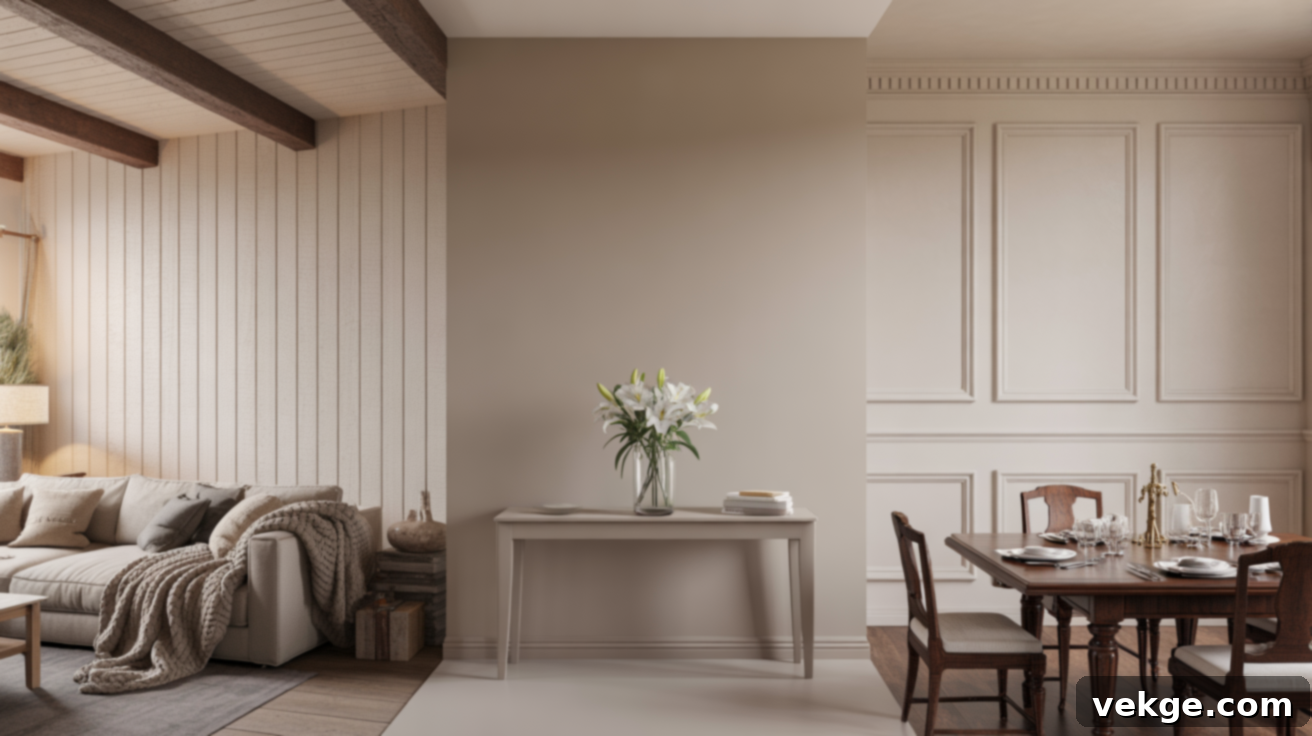
The architectural and interior design style of your home plays a significant role in determining the most harmonious wall treatment. Board and batten fits perfectly within farmhouse, rustic, coastal, or even Scandinavian-inspired homes, where natural textures, clean lines, and a sense of inviting warmth are highly valued. Its straightforward yet impactful pattern complements these aesthetics effortlessly.
Wainscoting, on the other hand, harmonizes exceptionally well with colonial, traditional, and classic homes, adding an undeniable layer of historic charm and refined elegance. For homes with a more modern or minimalist aesthetic, a simplified version of board and batten with very clean lines and a monochromatic color scheme can work wonderfully, maintaining a sleek and contemporary feel. Transitional homes, which blend traditional and modern elements, might find success with either style depending on the specific furniture and decor choices.
Wall Treatment Comparison Table: Beyond Board and Batten & Wainscoting
While board and batten and wainscoting are immensely popular, they are by no means the only options for enhancing your walls. Other beloved wall treatments like beadboard and shiplap also offer unique aesthetics and benefits, making it valuable to compare them side-by-side to ensure you make the most informed decision for your space.
| Feature | Board and Batten | Wainscoting | Shiplap | Beadboard |
|---|---|---|---|---|
| Panel Direction | Vertical boards with battens covering seams. | Flat or raised panels with decorative trim, often vertical or framed. | Horizontal boards with slight, overlapping gaps (nickel gap). | Narrow, vertical tongue-and-groove planks or sheets with continuous grooves (beads). |
| Wall Coverage | Often full wall height for dramatic impact, or partial. | Typically covers the lower third to three-quarters of the wall. | Can be full wall, accent wall, or partial wall coverage. | Usually applied as a lower wall section (wainscoting style) or small accents. |
| Style Vibe | Bold, modern farmhouse, contemporary, structured. | Traditional, classic, formal, elegant, historic. | Relaxed, rustic, coastal, modern farmhouse, casual. | Soft, cottage-like, vintage, quaint, comforting. |
| Best For | Entryways, bedrooms, offices, living rooms, accent walls. | Hallways, dining rooms, bathrooms, powder rooms, formal living spaces. | Living rooms, bedrooms, kitchens, accent walls, cozy nooks. | Bathrooms, kitchens, laundry rooms, kids’ rooms, small spaces. |
| Installation Skill | Moderate DIY for experienced individuals; professional recommended for perfection. | Advanced carpentry often needed due to intricate cuts and panel fitting. | Easy to moderate DIY, as boards are typically uniform and forgiving. | Easy for most DIYers, especially with pre-fabricated sheets. |
| Visual Impact | Strong vertical lines add height and a sense of architectural grandeur. | Adds structure, depth, and charm, visually anchoring the lower wall. | Wide horizontal lines visually open up the space and add character. | Creates a cozy, fine-textured surface with subtle vertical lines. |
Ensuring Longevity: How to Maintain Your Wall Panels
These beautiful wall styles aren’t just about initial aesthetics; their long-term appeal and durability depend significantly on proper cleaning and maintenance, especially in areas subject to daily wear and environmental factors.
Cleaning and General Maintenance Tips
Both board and batten and wainscoting are relatively easy to clean, primarily because their painted or stained surfaces can generally be wiped down. For routine cleaning, a soft, damp cloth or sponge is usually sufficient to remove dust and light smudges. For more stubborn marks, a mild soap solution can be used, followed by a clean, damp wipe. It’s crucial, however, to be mindful of potential dents or scratches, particularly on real wood installations. Promptly addressing any damage helps preserve the finish. Wainscoting, with its often more intricate trim and recessed panels, may accumulate dust in crevices, requiring a soft brush attachment on a vacuum cleaner or a duster to keep it pristine.
Long-Term Use in Humid Rooms: Kitchens and Bathrooms
Rooms like bathrooms and kitchens, which frequently experience high levels of humidity, steam, and splashes, demand careful consideration when choosing wall treatments. The good news is that both wainscoting and board and batten can perform well in these challenging environments with the right preparation.
Wainscoting is frequently chosen for bathrooms due to its ability to protect the lower half of the wall. When properly installed and painted with high-quality, moisture-resistant paint (such as semi-gloss or satin finishes), it can effectively repel water and resist mildew. Using a water-resistant material like MDF or even PVC trim is advisable in these areas.
Board and batten can also thrive in humid spaces, provided you use moisture-resistant materials for the boards and battens themselves. MDF (Medium-Density Fiberboard) specifically designed for humid environments or even PVC trims are excellent choices. Crucially, all edges and seams must be thoroughly sealed with caulk before painting. This creates a protective barrier against moisture infiltration, preventing warping, swelling, and paint peeling over time. Regular inspection for any cracks in the sealant is a good practice to ensure long-term durability in these damp areas.
Enhancing Your Wall Panels: The Power of Trim and Accents
The subtle details of trim and accents can elevate your wall treatments from good to truly exceptional, providing a polished, custom, and complete appearance that ties the entire room together.
- Crown Molding: Adding crown molding where the wall meets the ceiling creates an elegant transition and visually lifts the ceiling, making the room feel taller and more expansive. It completes the architectural look, especially with wainscoting.
- Chair Rails: While wainscoting often incorporates a chair rail as its top border, it can also be used with partial board and batten or to delineate a painted section from a wallpapered section above. Beyond aesthetics, chair rails protect walls from scuffs caused by furniture.
- Baseboards: Installing sturdy, well-chosen baseboards at the bottom creates a clean, intentional edge where the wall treatment meets the floor. They act as a finishing touch, adding visual weight and protecting the very lowest part of the wall.
- Proportionate Trim Sizes: The scale of your trim should match the scale of your room. Larger rooms can accommodate thicker, more substantial pieces, while smaller rooms benefit from narrower, more delicate trims to avoid overwhelming the space.
- Paint Choices: Painting all trim work the same color as your wall treatment creates a seamless, built-in look. Alternatively, using a contrasting color for the trim can create a bolder statement and highlight the architectural details. Consider contrasting the trim color with the wall above it for wainscoting.
Thoughtful trim details give both board and batten and wainscoting a professional, bespoke appearance, making them feel like an inherent part of your home’s architecture. Don’t overlook these small touches; they are instrumental in achieving a truly refined and cohesive interior design.
Conclusion: Your Path to Beautifully Transformed Walls
Adding architectural texture to your walls can profoundly alter the ambiance and perceived value of any room. Having explored the distinct characteristics of board and batten versus wainscoting, you are now equipped with the knowledge to make an informed decision that perfectly aligns with your home’s unique style and your personal taste. We’ve journeyed through their visual impact, ideal room applications, installation considerations, and the importance of long-term maintenance.
Whether you’re drawn to the bold, vertical lines of board and batten to create a sense of height and modern charm, or the classic elegance of wainscoting to add warmth and protective sophistication, even a single accent wall can dramatically elevate your space. Remember, starting small can be an excellent way to experiment and truly discover what resonates with your aesthetic preferences. If this guide has illuminated your path to a wall transformation, you’re ready for the next exciting step in your home improvement journey. Feel free to explore other blogs on our website for more easy home updates and design inspiration you can confidently try.
